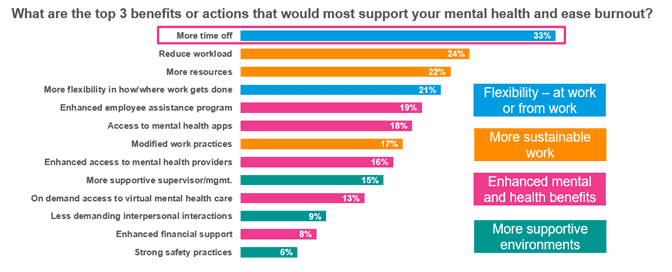You are a Benefits Manager at a 1,000-life company, where you work hard to manage costs, retain key talent, communicate the value of benefits, and ensure that they are available when employees need them. Your phone rings and it’s an employee seeking help. Their child has been struggling with their mental health and they can’t get the care they need. This employee has been worried about their child for months, unsure if it’s a passing phase or a more serious issue that requires additional support.

Over the weekend, the situation worsened and this employee is scared and needs to secure immediate care for their child. They called your medical carrier who is trying to assist them in finding an in-network psychiatrist, but the earliest available appointment is 43 days away. The parent, unwilling to wait 43 days for answers, calls their primary care doctor who expresses concern about the severity of the issue. The doctor recommends the parent take their child to the emergency room. From there your employee, tries to navigate the maze that is the United States (US) mental health care system, which includes a shortage of providers, limited number of specialists in-network, and their child that needs help.
We wish this story was less common than it is today but as many 25% of parents indicated their kids are feeling down, depressed, or hopeless all the time according to the Calm Business 2023 Workplace Mental Health Trends Report. The statistics don’t get more encouraging when we look at adult mental health:

The COVID-19 pandemic brought the mental health crisis in America into the forefront. While some employers have increased benefits and programs, others are wondering what they can do to actually move the needle on mental health compass. Employers cannot fix a broken mental health care system, but they can address four key areas within their benefit offerings: cost, access, stigma, and influences.
Cost of treatment
According to The State of Mental Health In America, a report released by Mental Health America in 2023, 28% of all adults reported not receiving needed treatment due to affordability. Employers should assess the affordability of their medical plans, including deductibles and copays. They can also explore lower-cost options like free visits under the Employee Assistance Program and tele-behavioral health solutions. Additionally, employers should ensure their medical carrier has an adequate mental health network to avoid out-of-network charges.
Access to providers
In the U.S. there are 350 individuals for every one mental health provider according to the State of Mental Health report in America. The need for mental health providers greatly outweighs the supply. Several ways plan sponsors can look to address access include:
- Offering a comprehensive Employee Assistance Program with more included visits and the ability care back to an in-network provider of the medical carrier.
- Offering tele-behavioral health options.
- Offering digital mental health solutions as a supplement, not to substitute for care that should be offered under the medical and prescription drug plan benefits.
- Offering a points solution focused on mental health services through your carrier or via a direct contract including member navigation, triaging of needs to fast track more serious mental health issues.
Stigma around mental health
Despite the increasing need for mental health support, stigma remains a barrier. Employers need to normalize the conversation on mental health in the workplace, so employees and their family members get the care they need. The MindShare Partners 2023 Mental Health at Work Report pointed to the need for employers to do more in terms of enabling employees to feel more comfortable talking about their mental health at work.

Question
Answer Option
2023
I would feel comfortable talking about my own mental health to…
My family
My friends
A work colleague
My manager
Someone in HR
Senior leaders in my company
The CEO (or equivalent) of my company
62%
63%
34%
34%
28%
19%
17%
I have talked to someone about my mental health in a workplace setting…
Never
In the past week
In the past month
In the past 6 months
In the past year
58%
7%
13%
12%
11%
What was the experience like talking to someone at your company about your mental health?
Received a positive or supportive response
Received a neutral response
Received a negative or unsupportive response
61%
23%
7%
What might stop you from approaching someone at work who you think might need support around their mental health (Top 5 answers)
At least one obstacle
Not wanting to offend or make someone uncomfortable
Feeling awkward, no right place or time
Not sure how to start the conversation or what to say
Not wanting to intervene in their personal struggles
Not having had any appropriate training
87%
45%
37%
33%
31%
24%
Source: “2023 Mental Health at Work Report,” MindShare Partners
Strategies may include manager training, anti-stigma campaigns, employee testimonials, and launching employee resource groups (ERGs) to address specific subpopulations. ERGs bringing together these individuals and helps them gain insight into their shared experience and brings to light more ways to help support the entire population.
Influences on mental health
Employers should understand what is driving increased mental health needs and consider they can impact them through the benefits, internal policies, and overall company culture. Understanding drivers of stress is a popular strategy for employers to consider including factors such as:
- Inequities in healthcare or generally in society, having a focus on diversity, equity and inclusion (DE&I) will help employers understand how mental health prevalence risk factors and incidence rates are higher among historically marginalized populations.
- Understanding the impact of social determinants of health, including how individuals may be more adversely impacted by access and affordability based on where they live.
- Company culture, including factors like flexibility in where work gets done and ability to take time off, navigating and avoiding burnout, and having supportive management.
The 2023-24 Mercer’s Inside Employees Mind survey looked to capture what employees felt would most support their mental health and ease burnout, more time off was the highest ranked strategy:

Data is emerging to help employers understand the link between culture, productivity, and mental health. The Workforce Institute at UKG released Mental Health at Work: Managers and Money in 2023–a survey of 3,400 employees across 10 countries and the results were staggering:
- 60% of employees worldwide say their job is the biggest factor influencing their mental health.
- Managers have just as much of an impact on people’s mental health as their spouse (both 69%) — and even more of an impact than their doctor (51%) or therapist (41%).
- 81% of employees worldwide would prioritize good mental health over a high-paying job, and 64% admit they would take a pay cut for a job that better supports their mental wellness.
Financial stress is a major concern for employees–with everything from student loan repayments to unaffordable housing markets and general inflation to medical debt, there are many stressors weighing heavy on employees. Employers can address financial stressors by offering financial well-being programs, such as counseling, discount programs, student loan programs, emergency hardship funds, and supplemental health benefits.
Despite tight budgets in 2024, many employers recognize the need to invest more in combating mental health issues. 94% of large employers (500 or more employees) have already strengthened their coverage for mental health care, increased support, or implemented new programs or systems in the last three years1.
How can Marsh McLennan Agency Help?
Your Marsh McLennan Agency account team can help you understand the latest trends and strategies employers are using to support mental well-being, navigate growing compliance requirements under Mental Health Parity, and design mental health strategies, targeted communications, time away from work strategies, as well as financial counseling through MMA Prosper WiseSM.
You can also learn more by visiting Well-being Your Way, with more tools and resources including Mental Health Playbooks, a 12-month Anti-Stigma campaign and so much more. Together, we can move the needle on mental health for your employees, their families, and your firm.





